Differences Between Majesty Palm Vs Cat Palm
Majesty palms have a longer lifespan, but cannot tolerate low light levels. They are bigger in size though. Whereas cat palms are more compact and tolerate low light better.
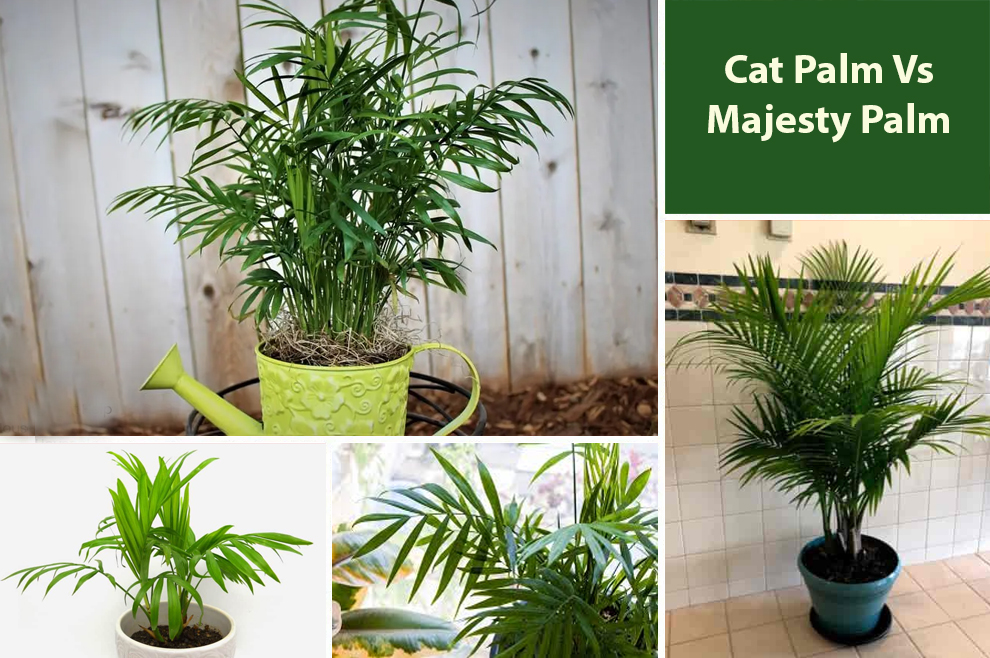
Cat Palm (or Chamaedorea Cataractarum) and Majesty Palm (or Ravenea Rivularis) are popular outdoor and indoor ornamental Palms native to tropical regions. Comparing Cat Palm vs Majesty Palm, the former is smaller and more compact than the latter.
Cat palms usually grow between six and eight feet and have a clumping habit. Cat Palms have arching and feathery fronds. People mostly grow the Cat Palms in shaded outdoor landscapes or as houseplants.
Cat Palms are known for their air-purifying abilities and the ability to withstand low light conditions.
On the contrary, the Majesty Palms are much larger and grow up to 100 feet in their natural habit. They have fan-shaped, large fronds and single trunks and are typically grown as outdoor ornamental or indoor Palms in tropical and warm regions.
The Majesty Palms prefer indirect, bright sun and regular watering to maintain their lush foliage. They are usually specimen trees and are part of the tropical landscape design.
The primary Majesty Palm vs Cat Palm difference is in their growth habit and size. While the latter is smaller and more clumping, the Majesty Palm is larger and has a single trunk.
Further, the Cat Palms are more tolerant to low light conditions and are more commonly grown as houseplants, whereas the Majesty Palms cherish brighter light and are better picks for outdoor landscapes.
Majesty Vs Cat Palm Overview
| Cat Palm | Majesty Palm | |
| Hardiness zone | Nine through Eleven | Nine through Eleven |
| Leaves (color, shape, size) | Dark green, pinnate, feathery, up to 4 feet long | Dark green, pinnate, fan-shaped, up to 8 feet long |
| Height and width | Up to 6-8 feet tall and 4-6 feet wide | 10-100 feet tall, 6–20 feet wide |
| Stem | Clumping, multiple stems | Single, straight trunk |
| Growth rate | Slow to moderate | Moderate to fast |
| Lifespan | 5-7 years indoors, longer outdoors | Up to 25 years |
| Indoor or outdoor or both | Indoor and outdoor in warm climates | Indoor and outdoor in warm climates |
| Soil type | Well-draining, rich soil, but can tolerate a wider range of soil pH | Well-draining, rich soil, but may suffer if the soil pH is too alkaline or too acidic |
| Sun requirements | Bright, indirect light or partial shade, but more tolerant to lower light levels | Bright, indirect light and cannot tolerate low light levels |
| Watering | Relatively lesser watering requirements | Need more water |
| Humidity | Less sensitive to dry air | More sensitive to dry air |
| Temperature | Prefer temperature over 60°F | Can handle temperatures as low as 50°F |
| Pest and diseases | Mealybugs, spider mites, scale – Usually resistant | Spider mites, mealybugs, fungal diseases – More susceptible than Cat Palm |
| Toxicity | Non-toxic to pets | Non-toxic to pets |
Cat Palm: How To Identify It?
A famous indoor Palm variety, Cat Palm is easy to identify with its distinctive features. Here are some of its standout features:
1. Leaves: The Cat Palm has arching, feathery fronds that grow from its central stem. Its leaves are typically bright green and grow to two to three feet.
2. Height: The Cat Palm grows to six to eight feet tall when mature. But it takes several years to reach this height.
3. Trunk: Cat Palm trunk is thin. It is covered in a fibrous material and is usually multi-stemmed, with several stems growing from the same root system.
4. Fruit and flowers: The Cat Palm has yellow, small flowers that grow in clusters near the leaf’s base. Berries follow the flowers and attract birds and other wildlife.
5. Growing requirements: Cat Palm care includes indirect, bright sun and demands regular watering to keep its soil moist. It also benefits from regular fertilization and occasional pruning to remove dead and damaged fronds.
What Does A Majesty Palm Look Like?
It is a popular palm plant variety. You can identify it with its distinctive features.
1. Leaves: The Majesty Palm has feathery, long fronds that grow from its central stem. Its leaves are typically dark green and grow to six to eight feet.
2. Height: The plant grows between 10 and 100 feet tall when mature, depending on how and where you grow them.
3. Trunk: These have a thin trunk covered in fibrous material. The trunk can be gray or brown with several scars or rings from the old fronds.
4. Fruits and flowers: These produce small, white flowers that grow in clusters around the leaf’s base. Soon after, round, small fruits follow flowers that turn black when ripe.
5. Majesty palm care: The plant cherishes bright, indirect light and regular watering. It also benefits from occasional pruning and regular fertilization for healthy growth.
Cat Palm Vs Majesty Palm Comparison
These are both popular indoor plants but look good even outdoors. They can add a tropical touch to any environment. But there are some differences between the two.
Read below as we discuss the main differences between these two Palm varieties:
A. Differences in cat palm and majesty palm leaf appearance
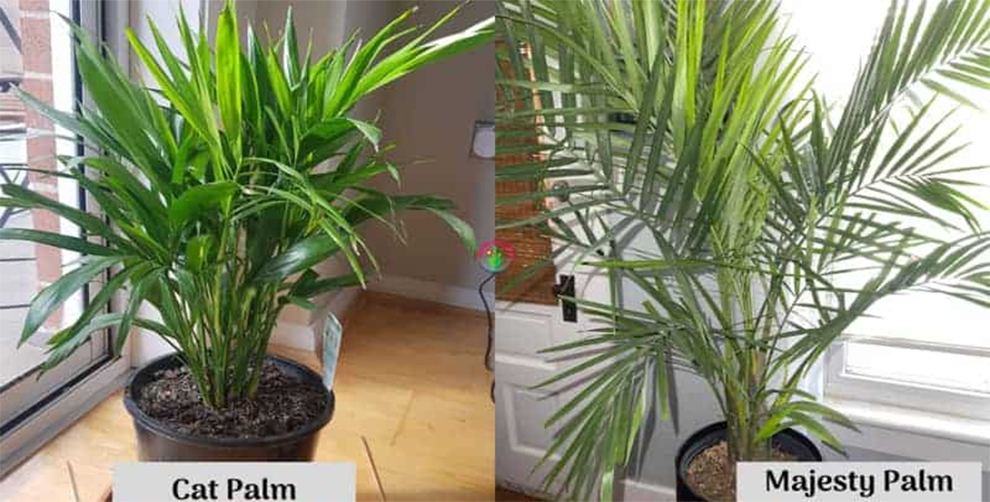
There is a difference between the palm leaf appearance and size of both palms. The latter has longer, wider, and fuller leaves than the Cat Palm. The Majesty Palm’s leaves are typically dark green and grow six to eight feet.
On the contrary, the Cat Palm has bright green leaves that grow up to two to three feet. Majesty Palm’s leaves have a more pronounced central vein that gives them a more structured appearance, whereas the Cat Palm has slender and delicate leaves.
B. Cat and majesty palm height
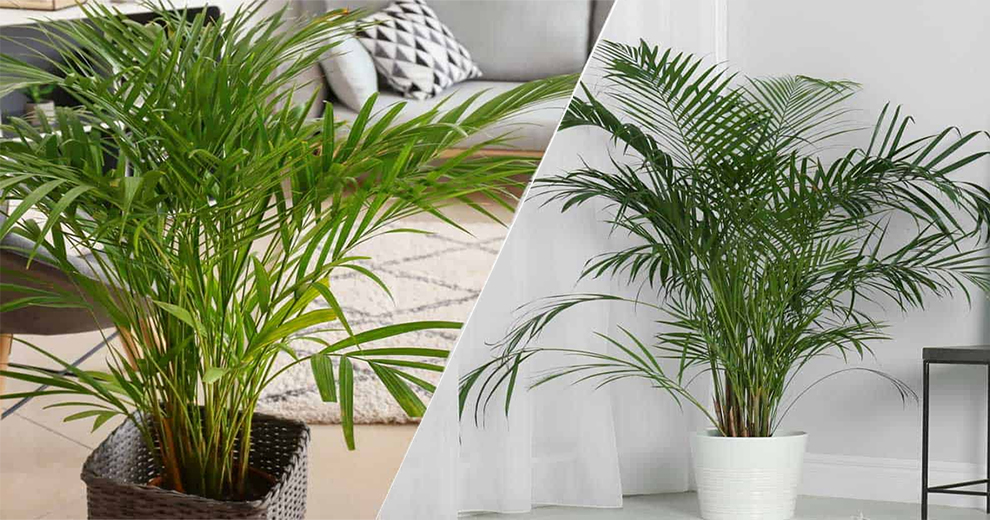
Majesty Palms usually grow up to 10-100 feet upon maturity, whereas Cat Palms can grow around six to eight feet.
But their growth rate and ultimate height depend on their growing conditions, including the nutrients, water, and light they receive and the container or space you plant them in.
C. Growth pattern or shape of the plant
As for the general appearance, Majesty Palms have a compact and more upright growth pattern with a central trunk that can produce several fronds in a circular arrangement.
In addition, the fronds from Majesty Palms are more densely packed and form a fuller canopy than the more delicate and open canopy.
Comparing the Majesty Palm vs Cat Palm, we found that the latter has a more arching growth pattern with fronds that tend to droop down, giving it a more natural and relaxed appearance. Cat Palm produces multiple stems from its single root system, creating a bushier look.
D. Differences in growing requirements of cat and majesty palm
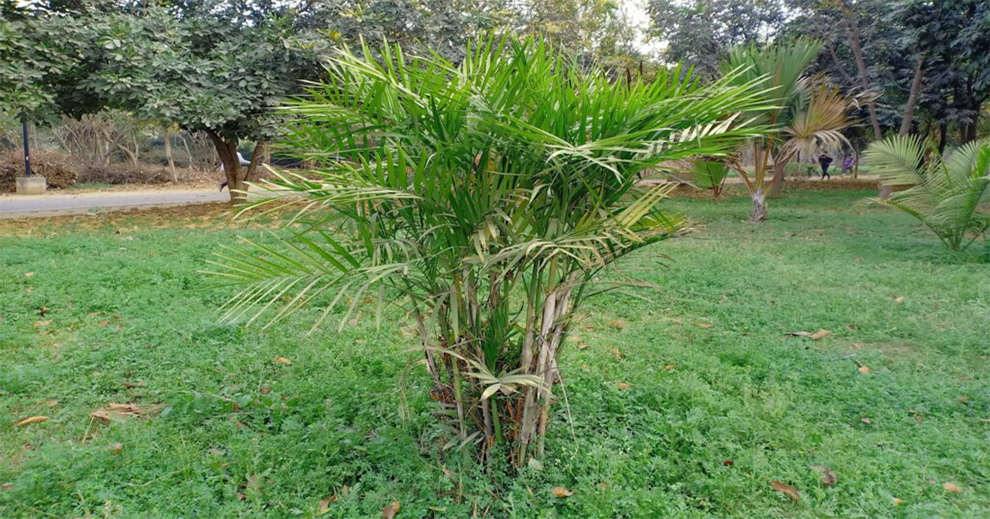
Here are some differences in the growing requirements between Cat Palms and Majesty Palms:
1. Temperatures: Both these Palms cherish warm temperatures. However, the Majesty Palms can tolerate a relatively cooler temperature than the Cat Palms. The Majesty Palms can handle temperatures as low as 50°F (10°C), whereas the Cat Palms prefer temperatures over 60°F (15°C).
2. Light: Both Cat Palms and Majesty Palm love indirect, bright light. However, the former is more tolerant to lower light conditions than the Majesty Palms. Sadly, Majesty Palms suffer if you do not give them ample light, whereas the Cat Palms can tolerate lower light conditions and some shade.
3. Humidity: Both Cat Palms and Majesty Palms love the humid environment. However, the latter is more sensitive to dry air than the Cat Palms. Majesty Palms benefit from regular misting or a humidifier, whereas the Cat Palms can endure drier air too.
4. Watering: Majesty Palms and Cat Palms both demand regular watering to keep the soil moist. However, Majesty Palms need more water than the Cat Palms. Majesty Palms cherish consistently moist soil, whereas the Cat Palms can tolerate slightly drier soil.
5. Fertilization: Majesty Palms and Cat Palms can both benefit from regular fertilization. However, the former needs more frequent plant food than the latter. Fertilize the Majesty Palms at least once every two to three months, whereas the Cat Palms can be fertilized once every four to six months.
6. Soil pH: Majesty palm thrives in nutrient rich soil. Both Majesty Palms and Cat Palms also grow well in acidic to neutral soil with a pH between 6 and 7. However, Cat Palms are more low-maintenance and can tolerate a range of soil pH than the Majesty Palms.
On the contrary, the Majesty Palms suffer if the soil pH is too acidic or alkaline, whereas Cat Palms are more adaptable to different soil conditions.
E. Which one is more prone to pests and diseases cat palm or majesty palm?
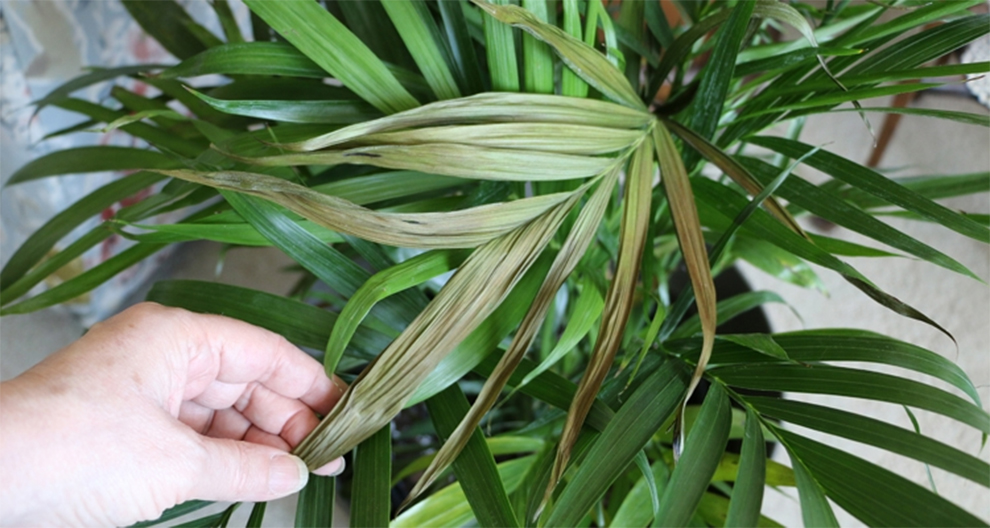
Cat Palm and Majesty Palm are susceptible to pests and diseases, but Majesty Palm is generally considered more prone to issues.
But both can resist pests and diseases if you grow them in the right conditions and offer them proper care. Majesty Palms are more susceptible to scale insects, spider mites, and mealy bugs, especially if you grow them in low humidity or overwater them.
It can damage the leaves and weaken the plant. Further, they may also develop fungal diseases like root rot if you keep the soil too wet. It may cause plant decline or death. They may also be prone to fungal infection if humidity is high or you expose them to cold drafts.
On the contrary, comparing Cat vs Majesty Palm, the latter are more generally more resistant to pests and diseases. However, under poor conditions, they may be susceptible to spider mites. Further, they may also develop leaf spots if you keep their leaves wet for a long.
Generally, you can keep these plants pest-free and healthy by offering them suitable growing conditions, avoiding under or overwatering, and monitoring for signs of diseases or pests.
If the diseases are detected, prompt treatment with apt fungicides or insecticides is necessary to avoid further damage.
F. Toxicity
They are both non-toxic to pets and humans. Hence, they are safe to grow in households with children and animals. They do not present any harmful effects if ingested, but you must keep them off the reach of pets and small children to avoid accidental ingestion or mishaps.
G. Which plant is easier to care for?
Generally, Cat Palms are easier to care for than Majesty Palms. Thus, they are suitable for beginners or those seeking a low-maintenance Palm. Cat Palms can endure drier soil conditions and low light levels and are more adaptable to different humidity and temperature levels.
Majesty Palms demand more specific growing conditions and are sensitive to temperature, humidity, and water changes. They require more frequent watering, indirect bright light, and higher humidity to thrive. Hence, comparing Majesty vs Cat Palm, the former seeks more care and attention than the Cat Palms.
As for the environment, both plants are ideal for indoor growing in offices, homes, or other indoor spaces that offer adequate humidity and bright, indirect light.
But Cat Palms can be a better choice for those who reside in drier homes or climates with lower humidity, whereas Majesty Palms are perfect for people who live in tropical climates or homes with high humidity.
H. Which is meant for indoors?
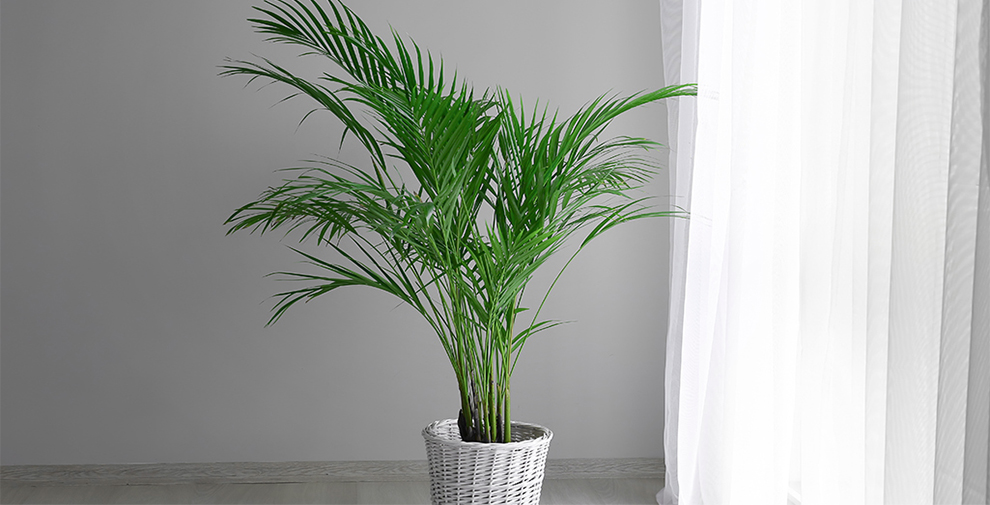
Both can be excellent indoor plants that add a beautiful, tropical touch to your space. They are adaptable to different environments and can withstand low light levels. But if you grow them indoors, you must offer them indirect, bright sun, high humidity, and consistent watering.
The plants are susceptible to damage from dry air, low humidity, and overwatering. Thus, you must monitor the growing conditions and make amends as needed.
Generally, the difference between Cat Palm and Majesty Palm is also that Cat Palms is a better pick for indoor growing in low-light conditions, whereas Majesty Palms need bright light and higher humidity to thrive indoors. You must ensure their pots are well-draining and the soil is of good quality to avoid root rot.
Both will benefit from occasional pruning and regular feeding to maintain their appearance and promote healthy growth. Majesty and Cat Palms can be good low-maintenance indoor plants with good care.
